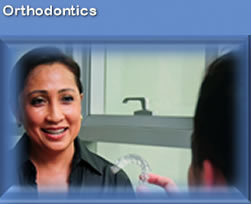We ensure personalized care through our diversified services.
Invisalign - a series of clear, removable teeth aligners that are an alternative to traditional metal dental braces. Your Invisalign treatment will consist of a series of aligners that you switch out about every two weeks. Each aligner is individually manufactured with exact calculations to gradually shift your teeth into place. Aligners are generally not used for complex orthodontic cases, such as when extractions, jaw surgery, or palate expansion are necessary.
Cosmetic Brackets - serve as a cosmetic alternative to traditional metal braces by blending in more with the natural color of the teeth. Typically, these brackets are made of ceramic, sapphire, or plastic materials and function in a similar manner to traditional metal brackets. Clear elastic ties and white metal ties are available to be used with these clear braces to help keep the appliances less conspicuous. Clear braces have a higher component of friction and tend to be more brittle than metal braces.
Metal Brackets - the most widely used in orthodontic treatment, which are made up of stainless steel and sometimes in combination with nickel titanium. These include conventional braces, which require ties to hold the archwire in place, and newer self-tying (or self-ligating) brackets. Self-ligating brackets may reduce friction between the wire and the slot of the bracket, which in turn might be of therapeutic benefit.
Lingual Orthodontics - braces that are placed on the inner surface of your teeth, next to the tongue. Unlike the usual braces, these do not show and are not visible with casual interaction. By comparison with the clear removable braces, which are also used where appearance is critical, the fixed brace allows greater control of teeth so lingual braces can manage more extreme irregularities of the teeth.
Myofunctional Appliance (Orthopedics) - removable or fixed orthodontic appliances which use forces generated by the stretching of muscles, bone, connective tissue, and gum surrounding and supporting a tooth to alter skeletal and dental relationships.
Retainers - are custom-made devices, made usually of wires or clear plastic, which hold teeth in position after surgery or any method of realigning teeth. They are most often used before or after dental braces to hold teeth in position while assisting the adjustment of the surrounding gums to changes in the bone.
Cosmetic Brackets - serve as a cosmetic alternative to traditional metal braces by blending in more with the natural color of the teeth. Typically, these brackets are made of ceramic, sapphire, or plastic materials and function in a similar manner to traditional metal brackets. Clear elastic ties and white metal ties are available to be used with these clear braces to help keep the appliances less conspicuous. Clear braces have a higher component of friction and tend to be more brittle than metal braces.
Metal Brackets - the most widely used in orthodontic treatment, which are made up of stainless steel and sometimes in combination with nickel titanium. These include conventional braces, which require ties to hold the archwire in place, and newer self-tying (or self-ligating) brackets. Self-ligating brackets may reduce friction between the wire and the slot of the bracket, which in turn might be of therapeutic benefit.
Lingual Orthodontics - braces that are placed on the inner surface of your teeth, next to the tongue. Unlike the usual braces, these do not show and are not visible with casual interaction. By comparison with the clear removable braces, which are also used where appearance is critical, the fixed brace allows greater control of teeth so lingual braces can manage more extreme irregularities of the teeth.
Myofunctional Appliance (Orthopedics) - removable or fixed orthodontic appliances which use forces generated by the stretching of muscles, bone, connective tissue, and gum surrounding and supporting a tooth to alter skeletal and dental relationships.
Retainers - are custom-made devices, made usually of wires or clear plastic, which hold teeth in position after surgery or any method of realigning teeth. They are most often used before or after dental braces to hold teeth in position while assisting the adjustment of the surrounding gums to changes in the bone.



